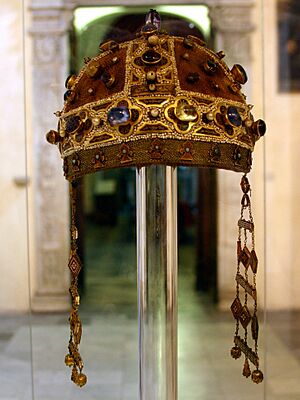Constance of Aragon facts for kids
Quick facts for kids Constance of Aragon |
|
|---|---|
| Queen consort of Hungary | |
| Tenure | 1198–1204 |
| Queen consort of Sicily | |
| Tenure | 15 August 1209 – 23 June 1222 |
| Coronation | 15 August 1209 |
| Queen consort of Germany | |
| Tenure | 9 December 1212/5 July 1215 – 23 April 1220 |
| Holy Roman Empress | |
| Tenure | 22 November 1220 – 23 June 1222 |
| Coronation | 22 November 1220 (Rome) |
| Born | 1179 Lisbon, Kingdom of Portugal |
| Died | 23 June 1222 (aged 42–43) Catania, Kingdom of Sicily |
| Burial | Cathedral of Palermo |
| Spouse | Emeric of Hungary Frederick II, Holy Roman Emperor |
| Issue | Ladislaus III of Hungary Henry (VII) of Germany |
| House | Barcelona |
| Father | Alfonso II of Aragon |
| Mother | Sancha of Castile |
Constance of Aragon (born 1179, died 1222) was a Spanish princess, also known as an infanta. She became a queen and empress through her marriages. First, she was the Queen of Hungary. Later, she became the Queen of Germany and Sicily, and even a Holy Roman Empress. She also ruled Sicily as a regent from 1212 to 1220.
Constance was the second child and oldest daughter of nine children. Her parents were Alfonso II of Aragon and Sancha of Castile.
Contents
Becoming Queen of Hungary
Constance's father passed away in 1196. Her brother, Peter II, became the new King of Aragon. He decided Constance's future.
King Peter arranged for Constance to marry King Emeric of Hungary. At nineteen years old, Constance left Aragon to travel to Hungary. Their wedding happened in 1198. Two years later, in 1200, Constance gave birth to a son named Ladislaus.
A Young King and a Difficult Time
When King Emeric was very ill, he crowned his son Ladislaus as co-ruler. This happened on August 26, 1204. The King wanted to make sure Ladislaus would become king safely. He asked his brother, Andrew, to protect Ladislaus. Andrew was also asked to help rule the Kingdom of Hungary until Ladislaus was old enough.
King Emeric died three months later, on November 30. Ladislaus became the new King. Andrew became his Regent, meaning he ruled for the young king. Andrew soon took all the power for himself. Ladislaus and Constance were almost like prisoners.
Constance managed to escape to Vienna with her son Ladislaus. They found safety at the court of Leopold VI, Duke of Austria. Sadly, Ladislaus died soon after, on May 7, 1205. Andrew II, who was now the King of Hungary, took his nephew's body. He buried Ladislaus in the Royal Crypt of Székesfehérvár. Duke Leopold then sent Constance back to Aragon.
Queen of Sicily and Holy Roman Empress
When Constance returned to Aragon, she lived with her mother, Queen Sancha. They stayed at the Abbey of Nuestra Senora, in Sijena. Queen Sancha had started this abbey after her husband died. She lived there in retirement.
Constance spent the next three years at the abbey with her mother. Then, her brother, King Peter II, changed her life again.
A New Marriage for Peace
King Peter II wanted to have a good relationship with Pope Innocent III. He needed the Pope's help to end his marriage to Maria of Montpellier. The Pope suggested that Constance, the former Queen of Hungary, marry his student. This student was the young King Frederick II, Holy Roman Emperor.
King Peter of Aragon agreed to this marriage. Constance left her mother and the abbey of Nuestra Senora. She began her journey to Sicily in 1208. She never returned to Aragon or saw her mother again. Queen Sancha died shortly after Constance left.
Becoming a Queen and Empress
Constance and Frederick were married in Messina, Sicily, on August 15, 1209. During the ceremony, she was crowned Queen of Sicily. Constance was thirty years old at this time, and her new husband was only fourteen. Two years later, in 1211, Constance gave birth to a son named Henry.
On December 9, 1212, Frederick was crowned King of Germany. He was crowned in opposition to Otto IV, Holy Roman Emperor. While her husband was away, Constance stayed in Sicily. She ruled the Kingdom as regent until 1220.
Frederick first controlled Southern Germany. Otto IV was removed from power on July 5, 1215. This time, Constance was crowned German Queen alongside her husband.
Pope Honorius III crowned Frederick Holy Roman Emperor on November 22, 1220. Constance was also crowned Holy Roman Empress. Their son Henry became the new King of Germany. Constance died less than two years later, in Catania. She passed away from malaria. She was buried in the Cathedral of Palermo. Her tomb is a Roman sarcophagus, and a beautiful crown, known as the Crown of Constance, was found with her.
See also
 In Spanish: Constanza de Aragón para niños
In Spanish: Constanza de Aragón para niños


